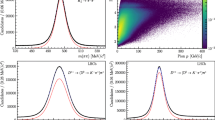Abstract
We report in this paper the alignment calibration of the STAR pixel detector (PXL) prototype for the RHIC 2013 run and performance study of the full PXL detector installed and commissioned in the RHIC 2014 run. PXL detector is the innermost two silicon layers of the STAR heavy flavor tracker aiming at high-precision reconstruction of secondary decay vertex of heavy flavor particles. To achieve the physics goals, the calibration work was done on the detector with high precision. A histogram-based method was successfully applied for the alignment calibration, and the detector efficiency after alignment was studied using both \(p+p\) collision data and cosmic ray data.











Similar content being viewed by others
References
S.A. Chin, Transition to hot quark matter in relativistic heavy-ion collision. Phys. Lett. B 78, 552 (1978). doi:10.1016/0370-2693(78)90637-8
J.I. Kapusta, Quantum chromodynamics at high temperature. Nucl. Phys. B 148, 461 (1979). doi:10.1016/0550-3213(79)90146-9
F.M. Liu, Explore QCD phase transition with thermal photons. Nucl. Sci. Tech. 24, 050524 (2013). doi:10.13538/j.1001-8042/nst.2013.05.024
H. Hahn, E. Forsyth, H. Foelsche et al., The RHIC design overview. Nucl. Instrum. Methods A 499, 245–263 (2003). doi:10.1016/S0168-9002(02)01938-1
Z. Lin, M. Gyulassy, Nuclear gluon shadowing via continuum lepton pairs in \(p+A\) at \(\sqrt{s}= 200\,A\) GeV. Phys. Rev. Lett. 77, 1222–1225 (1996). doi:10.1103/PhysRevLett.77.1222
Y. Zhang, J. Bouchet, X. Dong et al., Study of bottom production with the STAR Heavy Flavor Tracker. J. Phys. G Nucl. Part. Phys. 41, 025103 (2014). doi:10.1088/0954-3899/41/2/025103
L. Adamczyk, G. Agakishiev, M.M. Aggarwal et al., (STAR), Measurements of \(D^0\) and \(D^\ast \) production in \(p+p\) collisions at \(\sqrt{s}= 200\) GeV. Phys. Rev. D 86, 072013 (2012). doi:10.1103/PhysRevD.86.072013
L. Adamczyk, J.K. Adkins, G. Agakishiev et al., (STAR), Observation of \(D^0\) meson nuclear modifications in Au + Au collisions at \(\sqrt{s_{\text{ NN }}}= 200\) GeV. Phys. Rev. Lett. 113, 142301 (2014). doi:10.1103/PhysRevLett.113.142301
K.H. Ackermann, N. Adams, C. Adler et al., STAR detector overview. Nucl. Instrum. Methods A 499, 624–632 (2003). doi:10.1016/S0168-9002(02)01960-5
HFT proposal, http://rnc.lbl.gov/wieman/hft-final-submission-version.pdf
D. Beavis et al., The STAR Heavy Flavor Tracker Technical Design Report, https://drupal.star.bnl.gov/STAR/starnotes/public/sn0600
W.J. Llope et al., Multigap RPCs in the STAR experiment at RHIC. Nucl. Instrum. Methods A 661, S110–S113 (2012). doi:10.1016/j.nima.2010.07.086
M. Anderson, J. Berkovitz, W. Betts et al., The STAR time projection chamber: a unique tool for studying high multiplicity events at RHIC. Nucl. Instrum. Methods A 499, 659–678 (2003). doi:10.1016/S0168-9002(02)01964-2
M. Beddo, E. Bielick, T. Fornek et al., The STAR barrel electromagnetic calorimeter. Nucl. Instrum. Methods A 499, 725–739 (2003). doi:10.1016/S0168-9002(02)01970-8
STAR Collaboration, J. Adams, M.M. Aggarwal, Z. Ahammed et al., Pion, kaon, proton and anti-proton transverse momentum distributions from p + p and d + Au collisions at \(\sqrt{s_{\text{ NN }}}= 200\) GeV. Phys. Lett. B 616, 8–16 (2005). doi:10.1016/j.physletb.2005.04.041
C. Hu-Guo, J. Baudot, G. Bertolone et al., First reticule size MAPS with digital output and integrated zero suppression for the EUDET-JRA1 beam telescope. Nucl. Instrum. Methods A 623, 480–482 (2010). doi:10.1016/j.nima.2010.03.043
V. Karimaki et al., The HIP algorithm for track based alignment and its application to the CMS detector, CERN-CMS-NOTE-2006-018
V. Karimaki et al., Sensor alignment by traks—2003. Presented at CHEP. CMS CR-2004/009
X. Qin, R. Zhou, J.F. Han et al., GEANT4 simulation of the characteristic gamma-ray spectrum of TNT under soil induced by DT neutrons. Nucl. Sci. Tech. 26, 010501 (2015). doi:10.13538/j.1001-8042/nst.26.010501
Author information
Authors and Affiliations
Corresponding author
Additional information
This work was supported in part by the National Natural Science Foundation of China (No. 11421505) and the Major State Basic Research Development Program in China (No. 2014CB845400).
Rights and permissions
About this article
Cite this article
Ma, L., Dong, X., Qiu, H. et al. Alignment calibration and performance study of the STAR PXL detector. NUCL SCI TECH 28, 25 (2017). https://doi.org/10.1007/s41365-016-0177-4
Received:
Revised:
Accepted:
Published:
DOI: https://doi.org/10.1007/s41365-016-0177-4




